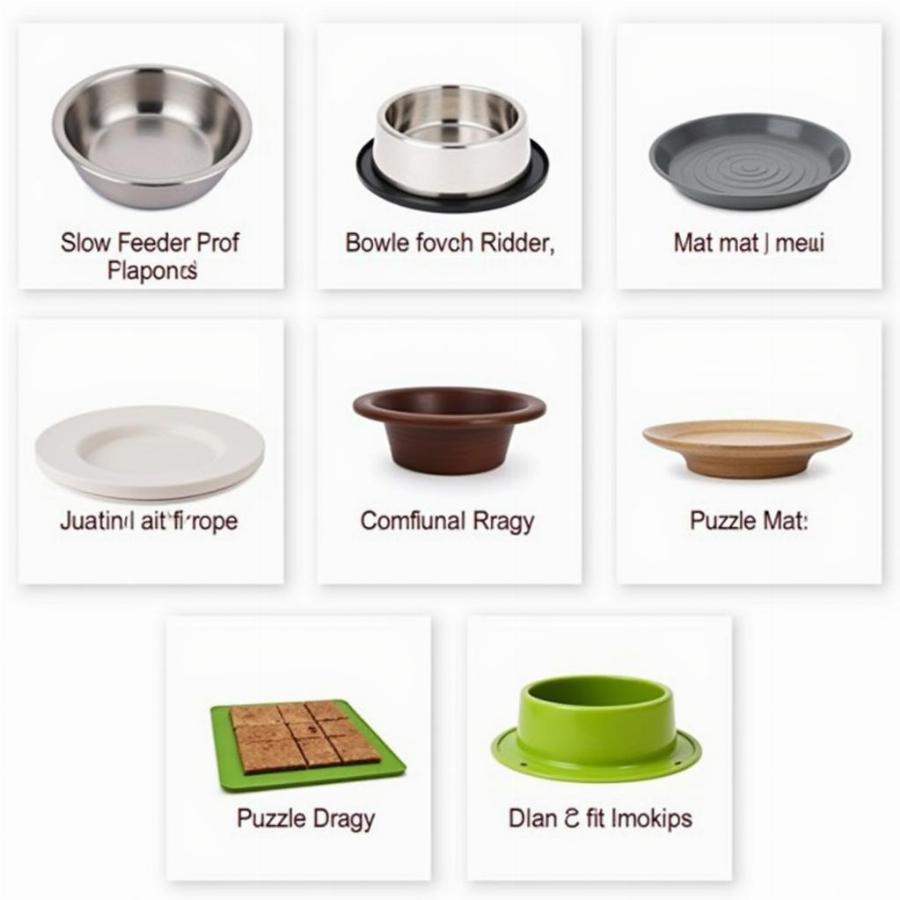Slow feeders for dogs are more than just trendy dog bowls. They’re a valuable tool for promoting healthier eating habits in our canine companions. If your dog inhales their food like it’s the last meal on Earth, a slow feeder can be a game-changer. This comprehensive guide dives deep into the world of slow feeders, exploring their benefits, various types, and how to choose the perfect one for your furry friend.
Why Use a Slow Feeder Dog Bowl?
Slow feeder dog bowls are designed to make mealtime more challenging, forcing dogs to eat at a slower pace. This simple change can have a significant impact on their health and wellbeing.
- Reduces the Risk of Bloat: Bloat, or Gastric Dilatation-Volvulus (GDV), is a life-threatening condition that can affect dogs, especially large breeds. By slowing down eating, slow feeders reduce the amount of air swallowed along with food, minimizing the risk of this dangerous condition.
- Improves Digestion: Eating too quickly can lead to indigestion and other digestive issues. Slow feeders encourage dogs to chew their food more thoroughly, aiding in proper digestion and nutrient absorption.
- Weight Management: For dogs prone to overeating, slow feeders can help control portion sizes and prevent weight gain. The increased chewing and slower pace can also lead to a feeling of fullness, helping your dog feel satisfied with less food.
- Mental Stimulation: The challenge of retrieving food from a slow feeder can provide mental stimulation for your dog, keeping them engaged and entertained during mealtime. This can be particularly beneficial for dogs prone to boredom or anxiety.
Choosing the Right Slow Feeder for Your Dog
With so many different slow feeders on the market, finding the perfect one for your dog can feel overwhelming. Consider these factors when making your selection:
- Size and Breed: small slow feeder dog bowl are ideal for smaller breeds, while larger breeds require a large slow feeder dog bowl.
- Material: Slow feeders are available in various materials, including plastic, ceramic, and stainless steel. A metal slow feeder dog bowl is generally more durable and hygienic.
- Design: The design of the slow feeder should match your dog’s eating style and skill level. Some feeders have simple raised ridges, while others feature more complex mazes and obstacles.
What are the Different Types of Slow Feeders?
- Bowls with Ridges and Obstacles: These are the most common type of slow feeder. The ridges and obstacles create a maze-like structure that forces dogs to work for their food.
- Mats: Slow feeder mats are flat, flexible mats with raised textures and patterns. They are a good option for dogs who tend to push their bowls around.
- Puzzle Toys: Some puzzle toys can also be used as slow feeders. These toys require dogs to solve puzzles or manipulate objects to release food.
 Different types of slow feeder bowls for dogs
Different types of slow feeder bowls for dogs
Slow Feeder Dog: Tips for a Smooth Transition
Introducing a slow feeder should be a gradual process. Start by offering a small amount of food in the slow feeder alongside their regular bowl. Gradually increase the amount of food in the slow feeder and decrease the amount in the regular bowl until your dog is solely using the slow feeder.
Dr. Emily Carter, DVM, a renowned veterinary nutritionist, advises, “Patience is key when introducing a slow feeder. Some dogs may initially be frustrated, but with gentle encouragement and positive reinforcement, they will adapt.”
How Do I Clean a Slow Feeder Dog Bowl?
Cleaning your dog’s slow feeder regularly is essential for maintaining hygiene. Most slow feeders are dishwasher safe, but hand washing with warm soapy water is also an effective method.
Conclusion
A slow feeder dog bowl is a simple yet effective way to improve your dog’s eating habits and overall health. By choosing the right slow feeder dogs and implementing it gradually, you can help your dog enjoy a slower, healthier, and more enjoyable mealtime.
FAQ
- Are slow feeders good for all dogs? Yes, slow feeders can benefit most dogs, especially those who eat too quickly.
- Can puppies use slow feeders? Yes, slow feeders are appropriate for puppies, as they can help establish healthy eating habits from a young age.
- What if my dog refuses to eat from a slow feeder? Try different designs or materials. You can also try adding a small amount of wet food or broth to the slow feeder to make it more appealing.
Find the best slow feeder dog bowl for your furry friend.
Beaut Dogs is your trusted source for all things dog-related. We’re passionate about providing valuable information to help you give your canine companion the best possible care. For personalized advice and support, contact us at Email: [email protected]. Beaut Dogs is here to help you navigate the wonderful world of dog ownership. Visit us at https://beautdogs.com.